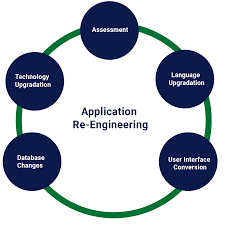I’ve witnessed how the learning landscape has dramatically evolved as someone immersed in technology and education. Watching traditional methods slowly advance to innovative, tech-driven solutions has been a fascinating journey. Among these, e-learning has emerged as one of the most transformative trends in the EdTech industry, reshaping how education is delivered and experienced.
However, as we push forward in this digital age, it’s become clear that the technology driving these platforms needs to keep pace. This is where application re-engineering comes into play. It’s not just about building something entirely from scratch; it’s about taking what exists and making it better—more efficient, engaging, and ultimately more effective for the end-users. In this blog post, I will delve into how application re-engineering, particularly within the EdTech space, revolutionizes learning platforms and why it should be on the radar of every education-focused organization.
The Evolution of Learning: From Chalkboards to Digital Platforms
Back when I was a student, learning was pretty straightforward. We had textbooks, chalkboards, and overhead projectors. Education was largely a one-size-fits-all approach, where the teacher was the primary source of knowledge, and students were passive recipients. Fast forward to today, and the scene is entirely different.
E-learning has caused a seismic shift in education. It’s flexible and accessible and caters to diverse learning styles. Students can learn at their own pace, access resources from anywhere in the world, and engage with interactive content that makes the experience more engaging and enjoyable. E-learning platforms have surged, especially in recent years, driven by the need for remote learning solutions during the pandemic.
But with this surge in demand comes the challenge of keeping these platforms up-to-date and capable of meeting the ever-evolving needs of students and educators. This is where application re-engineering comes in.
Understanding Application Re-engineering
Before discussing application re-engineering in EdTech, let’s define the term. In simple terms, application re-engineering is modifying an existing application to improve its performance, scalability, and functionality. It involves analyzing the current application, identifying areas that need improvement, and then redesigning or reworking those components to create a more robust solution.
Think of it as renovating a house. You’re not tearing down the entire structure but upgrading it—maybe knocking down a wall to create an open floor plan, adding a modern kitchen, or installing energy-efficient windows. The goal is to enhance the house’s overall functionality and aesthetic while retaining its core foundation. Similarly, application re-engineering aims to improve the existing application while preserving its essential features.
Why Application Re-engineering Matters in EdTech
In the context of EdTech, application re-engineering is crucial for several reasons. First and foremost, the educational landscape is continually evolving, with new pedagogical approaches, technologies, and user expectations emerging constantly. An application that was cutting-edge five years ago might feel outdated today. By re-engineering existing applications, EdTech companies can ensure their platforms remain relevant and capable of delivering high-quality educational experiences.
CodeSuite has seen this first-hand with some of our clients. Many of them initially developed their e-learning platforms years ago when the EdTech market was still in its infancy. At the same time, these platforms served their purpose, but struggled to keep up with modern users’ demands.
This is where our application re-engineering services come in. We help these organizations breathe new life into their platforms, making them more adaptable, scalable, and user-friendly. It’s about ensuring they can continue to meet their users’ needs while leveraging the latest technological advancements. This will enable them to stay ahead of the curve.
The Key Benefits of Application Re-engineering
Application re-engineering has several critical benefits, particularly in EdTech:
Improved User Experience
One of the most immediate benefits of application re-engineering is enhanced user experience. When we re-engineer an application, we look at it from the user’s perspective. How can we make it more intuitive? Are there features to add or clarified? Is navigation smooth and logical? By addressing these questions, we can create a more seamless and enjoyable experience for users. This is especially critical in an educational context where ease of use can directly impact learning outcomes.
Increased Scalability
As e-learning platforms grow in popularity, they need to handle more users. A platform that works well with a few hundred users might need help when that number rises to thousands or even millions. Application re-engineering allows us to optimize the platform’s architecture, making it more scalable and capable of supporting a growing user base without compromising performance.
Enhanced Security
In today’s digital world, security is paramount. Educational platforms often handle sensitive data, from student records to payment information. We can identify potential security vulnerabilities in the existing system through application re-engineering. We can also implement more robust security measures to protect against data breaches and cyberattacks. This safeguards users and builds trust in the platform.
Cost-Effective Modernization
Building an application from scratch can be costly and time-consuming. On the other hand, application re-engineering allows organizations to modernize their platforms cheaper. We can implement significant improvements without a complete overhaul by leveraging the existing infrastructure and codebase. This makes it a more feasible option for many organizations, especially those with budget constraints.
Future-Proofing
Finally, application re-engineering future-proofs EdTech platforms. Technology is constantly evolving, and what’s cutting-edge today might be obsolete tomorrow. By re-engineering applications and focusing on flexibility and adaptability, we can ensure they’re better equipped to integrate with evolving technologies and keep pace with future developments.
Real-World Applications of Re-engineering in EdTech
Let me share a couple of examples from our experience at CodeSuite to illustrate the impact of application re-engineering in EdTech.
Case Study 1: Enhancing a Learning Management System (LMS).
One of our clients, a well-established educational institution, struggled with and needed help with its Learning Management System (LMS). The platform had been in use for over a decade, and while it was functional, it was showing its age. The user interface could have been clearer, the system often crashed during peak usage times, and it lacked some modern features that students and educators expected.
Our CodeSuite team was brought in to re-engineer the LMS. We started by conducting a thorough analysis of the existing system, identifying critical areas for improvement. We then worked on modernizing the user interface, optimizing the backend architecture for better performance, and adding features like mobile compatibility and real-time analytics.
The result was a significantly improved LMS that met the institution’s current needs and was flexible enough to accommodate future growth. Students and educators gave overwhelmingly positive feedback, and the institution saw a noticeable increase in user engagement and satisfaction.
Case Study 2: Revamping an Educational App
Another project we worked on involved an educational app designed to help K-12 students with math. The app was popular when it launched, but over time, it became outdated. The graphics were dated, the content was static, and it wasn’t optimized for newer mobile devices.
We approached this project focusing on re-engaging the target audience. Our application re-engineering process involved updating the graphics and user interface to be more visually appealing, integrating interactive content to make learning more engaging, and ensuring the app was fully compatible with the latest mobile devices and operating systems.
The revamped app was a hit, with users praising its modern look and improved functionality. More importantly, the interactive content we introduced led to better learning outcomes, with students significantly enhancing their math skills.
The Future of EdTech and Re-engineering
Application re-engineering will continue to play a pivotal role in the EdTech industry. As new technologies emerge—like AI, AR/VR, and adaptive learning—there will be a growing need to integrate these innovations into existing platforms. Rather than starting from scratch, many organizations will find that re-engineering their current applications is the most efficient and cost-effective way to stay competitive and deliver cutting-edge educational experiences.
CodeSuite is excited to be at the forefront of this movement. Our experience in application re-engineering services has shown us how powerful this approach can transform learning platforms and enhance users’ educational experiences. Whether it’s upgrading a legacy system, modernizing an app, or integrating existing technologies, we’re committed to helping our clients stay ahead in the rapidly evolving world of EdTech.
Conclusion:
In conclusion, as someone who has spent years in the tech industry, I can confidently say that application re-engineering is not just a trend—it’s a necessity for any organization looking to thrive in today’s fast-paced digital world. For those in the EdTech space, re-engineering offers a path to revitalizing existing platforms, ensuring they remain relevant, engaging, and effective for users.
Whether you’re an educational institution with a legacy system that needs a refresh or a startup looking to enhance your e-learning app, application re-engineering could be the key to unlocking your platform’s full potential. At CodeSuite, we’re here to help you navigate this journey and ensure that your platform meets the needs of today’s users and is ready to take on the challenges of tomorrow.
So, if you’re ready to take your EdTech platform to the next level, don’t hesitate to reach out. Together, we can re-engineer your application and revolutionize the way education is delivered and experienced.







